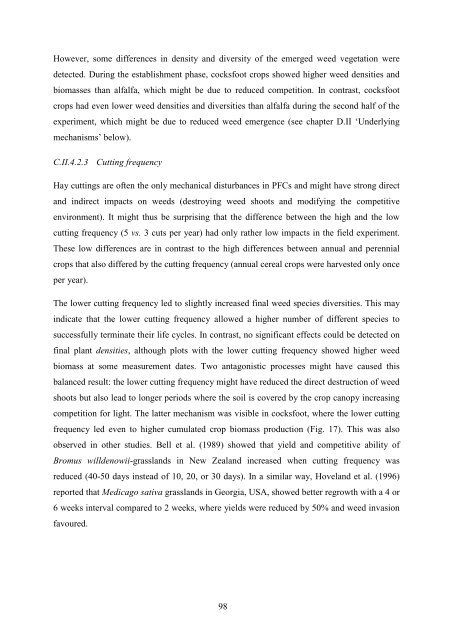Diversifying crop rotations with temporary grasslands - Université de ...
Diversifying crop rotations with temporary grasslands - Université de ...
Diversifying crop rotations with temporary grasslands - Université de ...
You also want an ePaper? Increase the reach of your titles
YUMPU automatically turns print PDFs into web optimized ePapers that Google loves.
However, some differences in <strong>de</strong>nsity and diversity of the emerged weed vegetation were<br />
<strong>de</strong>tected. During the establishment phase, cocksfoot <strong>crop</strong>s showed higher weed <strong>de</strong>nsities and<br />
biomasses than alfalfa, which might be due to reduced competition. In contrast, cocksfoot<br />
<strong>crop</strong>s had even lower weed <strong>de</strong>nsities and diversities than alfalfa during the second half of the<br />
experiment, which might be due to reduced weed emergence (see chapter D.II ‘Un<strong>de</strong>rlying<br />
mechanisms’ below).<br />
C.II.4.2.3 Cutting frequency<br />
Hay cuttings are often the only mechanical disturbances in PFCs and might have strong direct<br />
and indirect impacts on weeds (<strong>de</strong>stroying weed shoots and modifying the competitive<br />
environment). It might thus be surprising that the difference between the high and the low<br />
cutting frequency (5 vs. 3 cuts per year) had only rather low impacts in the field experiment.<br />
These low differences are in contrast to the high differences between annual and perennial<br />
<strong>crop</strong>s that also differed by the cutting frequency (annual cereal <strong>crop</strong>s were harvested only once<br />
per year).<br />
The lower cutting frequency led to slightly increased final weed species diversities. This may<br />
indicate that the lower cutting frequency allowed a higher number of different species to<br />
successfully terminate their life cycles. In contrast, no significant effects could be <strong>de</strong>tected on<br />
final plant <strong>de</strong>nsities, although plots <strong>with</strong> the lower cutting frequency showed higher weed<br />
biomass at some measurement dates. Two antagonistic processes might have caused this<br />
balanced result: the lower cutting frequency might have reduced the direct <strong>de</strong>struction of weed<br />
shoots but also lead to longer periods where the soil is covered by the <strong>crop</strong> canopy increasing<br />
competition for light. The latter mechanism was visible in cocksfoot, where the lower cutting<br />
frequency led even to higher cumulated <strong>crop</strong> biomass production (Fig. 17). This was also<br />
observed in other studies. Bell et al. (1989) showed that yield and competitive ability of<br />
Bromus will<strong>de</strong>nowii-<strong>grasslands</strong> in New Zealand increased when cutting frequency was<br />
reduced (40-50 days instead of 10, 20, or 30 days). In a similar way, Hoveland et al. (1996)<br />
reported that Medicago sativa <strong>grasslands</strong> in Georgia, USA, showed better regrowth <strong>with</strong> a 4 or<br />
6 weeks interval compared to 2 weeks, where yields were reduced by 50% and weed invasion<br />
favoured.<br />
98

















